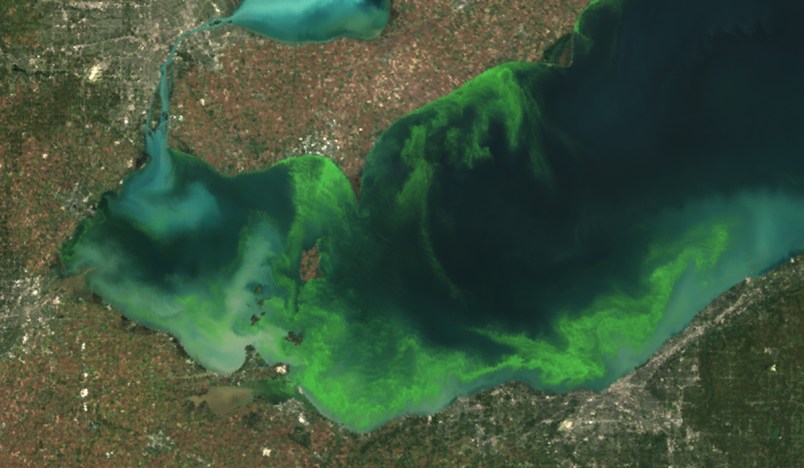This post has been updated.
TOLEDO, Ohio (AP) — More tests are needed to ensure that toxins are out of Toledo’s water supply, the mayor said Sunday, instructing the 400,000 people in the region to avoid drinking tap water for a second day.
“This is not over yet,” Mayor D. Michael Collins said, adding that new samples showing decreased levels of toxins in the water are a positive sign.
Toledo officials issued the warning early Saturday after tests at one treatment plant showed two sample readings for microcystin above the standard for consumption, possibly because of algae on Lake Erie. The city also said not to boil the water because that would only increase the toxin’s concentration. The mayor also warned that children should not shower or bathe in the water and that it shouldn’t be given to pets.
Long lines quickly formed at water distribution centers and store shelves were emptied of bottled water. The warning effectively cut off the water supply to Toledo, most of its suburbs and a few areas in southeastern Michigan.
City and state officials monitoring the water were waiting for a new set of samples to be analyzed Sunday at a federal lab in Cincinnati, Collins said.
Worried residents told not to drink, brush their teeth or wash dishes with the water waited hours for deliveries of bottled water from across Ohio as the governor declared a state of emergency.
Gov. John Kasich pledged that state agencies were working to bring water and other supplies to areas around Toledo while also assisting hospitals and other businesses affected.
“What’s more important than water? Water’s about life,” Kasich said. “We know it’s difficult. We know it’s frustrating.”
The governor said it was too early to say how long the water advisory will last or what caused toxins to spike suddenly in the drinking water.
“We don’t really want to speculate on this,” Kasich said. “When it comes to this water, we’ve got be very careful.”
Families toting empty coolers, milk jugs and even cookie jars topped them off with well water funneled out of the back of a pickup truck.
Tyshanta DeLoney, of Toledo, filled up a big plastic container after spending much of the day searching for water. “That was a blessing,” she said.
Late Saturday, Kasich ordered the state’s National Guard to deliver water purification systems, pallets of bottled water and ready-to-eat meals to residents in Lucas, Wood and Fulton counties.
The National Guard, alone, had produced 33,000 gallons of drinkable water by Sunday morning, and an additional 15,000 gallons had been delivered in collapsible containers.
The first tests indicating trouble came Friday night and additional testing confirmed the elevated readings, said Craig Butler, director of the state’s Environmental Protection Agency.
Algae blooms during the summer have become more frequent and troublesome around the western end of Lake Erie, the shallowest of the five Great Lakes.
The algae growth is fed by phosphorus mainly from farm fertilizer runoff and sewage treatment plants, leaving behind toxins that have contributed to oxygen-deprived dead zones where fish can’t survive. The toxins can kill animals and sicken humans.
Scientists had predicted a significant bloom of the blue-green algae this year, but they didn’t expect it to peak until early September.
There were no reports yet of people becoming sick from drinking the water, Collins said.
Operators of water plants all along Lake Erie, which supplies drinking water for 11 million people, have been concerned over the last few years about toxins fouling their supplies.
Almost a year ago, one township just east of Toledo told its 2,000 residents not to drink or use the water coming from their taps. That was believed to be the first time a city has banned residents from using the water because of toxins from algae in the lake.
Most water treatment plants along the western Lake Erie shoreline treat their water to combat the algae. Toledo spent about $4 million last year on chemicals to treat its water and combat the toxins.
Copyright 2014 The Associated Press. All rights reserved. This material may not be published, broadcast, rewritten or redistributed.







So what will it be? A wholesale change in the way farming is done in the Lake Erie basin, possibly leading to a national or even international trend? Or bottled and boiled water for the long haul while the environment gets ever worse?
There are select lakes, for example in Minnesota, where the EPA has applied especially tough phosphorous standards on sewage treatment and eutrophication and the resulting algae blooms has been successfully reversed. But nothing on the scale of a Great Lake, and nothing that I know of on farm runoff.
Well, this is what happens when you shit in your own dinner bowl…
Gee, maybe it’s in our enlightened self-interest to protect the health of the air and water and not describe every effort to do so as “job-killing.” I don’t think having an entire major city with hundreds of thousands of people without water is especially good for the economy in general or corporate profits in particular. In the meantime, sheesh—what are those people going to do? Microcystin is nasty stuff.
Kasich should go all ‘Rick Perry’ and schedule a ginormous
prayer meeting at Cleveland Stadium to pray away the algae.
There’s got to be a way to shut this science-y thing down.
jw1
‘Voter-killer’
That’s got to generate a tad more of the fear factor than ‘job-killer’ – no?
jw1